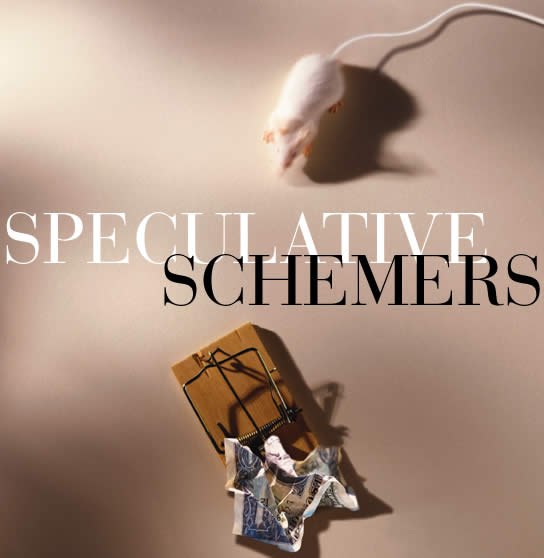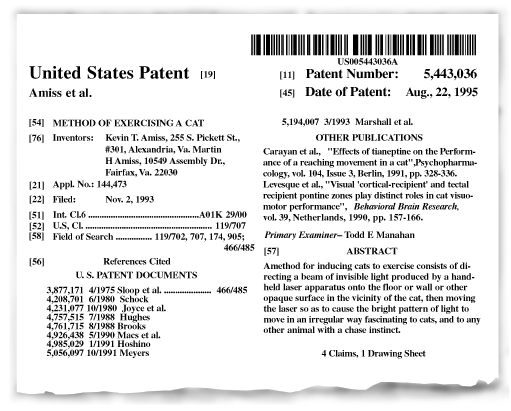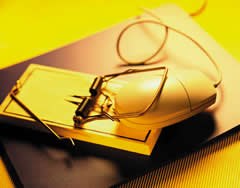
|
Bold entrepreneurs are trying
to patent business models in the digital economy
|

|
Most contemporary thinkers don’t regard
Ralph Waldo Emerson as much of a management thinker. The New
England transcendentalist was more concerned with matters of
the mind and spirit than cash-flow figures and motivation. But
Emerson did grasp one of the fundamental drivers of American-style
entrepreneurial capitalism. "If a man can write a better
book, preach a better sermon, or create a better mousetrap than
his neighbor," he wrote, "though he builds his house
in the woods the world will make a beaten path to his door."
|
 nventors,
tinkerers, and entrepreneurs have long been laboring in their houses
in the woods (and in their garages in the suburbs) to create the proverbial
better mousetrap. For more than two centuries, the desks of clerks
at the U.S. Patent and Trademark Office (USPTO) have been cluttered
with patent applications for wondrous new devices: a light bulb (Thomas
Edison, 1880), a flotation device (Abraham Lincoln, 1849), a new self-guidance
system for torpedoes (actress Hedy Lamarr, 1942), and a compound to
help sufferers of depression (Eli Lilly, Inc. The drug Prozac is covered
by six chemical patents granted between 1974 and 1986). In recent
years, patents have assumed an important role in the burgeoning field
of e-commerce. But not all patents are created equal: consider U.S.
Patent No. 5,443,036, granted in 1995, which is shown below.
nventors,
tinkerers, and entrepreneurs have long been laboring in their houses
in the woods (and in their garages in the suburbs) to create the proverbial
better mousetrap. For more than two centuries, the desks of clerks
at the U.S. Patent and Trademark Office (USPTO) have been cluttered
with patent applications for wondrous new devices: a light bulb (Thomas
Edison, 1880), a flotation device (Abraham Lincoln, 1849), a new self-guidance
system for torpedoes (actress Hedy Lamarr, 1942), and a compound to
help sufferers of depression (Eli Lilly, Inc. The drug Prozac is covered
by six chemical patents granted between 1974 and 1986). In recent
years, patents have assumed an important role in the burgeoning field
of e-commerce. But not all patents are created equal: consider U.S.
Patent No. 5,443,036, granted in 1995, which is shown below.

This is not a joke. The patent is
held by Messrs. Kevin Amiss and Martin Abbott, who managed to demonstrate
both the utility and novelty of using a laser pointer to play with
a cat. Now, it is possible the applicants and the USPTO were just
having fun. But the patent nonetheless illustrates an important trend.
It was not granted for a device, or a thing. Instead, it is a patent
for how to do something. Other intrepid inventors have been awarded
patents for methods of completing quotidian activities, like finding
the right bra size (No. 5,965,809) and hitting a tennis stroke while
wearing a knee pad (No. 5,993,366). While these patents may seem like
novelties, this trend is not entirely new. The USPTO has been awarding
so-called “methods” patents for decades. But in recent years,
the numbers have risen dramatically. And patenting “business
methods,” some of them stunningly obvious – such as using
a single mouse click to complete an online book order – has become
a hallmark of entrepreneurship in the digital economy.
The Background of Patents
The patent law of 1790 created an office that was empowered by the
Constitution to “Promote the Progress of Science and useful Arts,
by securing for limited Times to Authors and Inventors the exclusive
Right to their respective Writings and Discoveries” (Article
One, Section 8). In 211 years, the USPTO has established a proud tradition
of rewarding the development of technologies of all sorts (though
often for things that might seem at a distance to be trivial, or obvious,
or both). The objective has always been to draw out of the collective
genius inventions that would promote the good of the nation. But granting
patents can be a Faustian bargain. On the one hand, by commercially
rewarding the efforts of inventors, we call forth their creative efforts.
On the other hand, we create monopolies and all the evils that attend
them.
The patent laws grant inventors a
20-year window during which they – and only they – may exploit
the commercial potential of their work as they see fit. The philosophy
of the USPTO seems to embrace the ‘solitary genius’ model
of innovation, wherein the lone innovator receives protection from
competition while he or she perfects the reaper, or the cotton gin,
or the cellular phone. But other elements of our government have expressed
ambivalence about the granting of exclusive monopolies. “It was
never the object of patent laws to grant a monopoly for every trifling
device, every shadow of a shade of an idea, which would naturally
and spontaneously occur to any skilled mechanic or operator in the
ordinary progress of manufactures,” the Supreme Court ruled in
an 1882 case (Atlantic Works vs. Brady). “Such an indiscriminate
creation of exclusive privileges tends rather to obstruct than to
stimulate invention. It creates a class of speculative schemers who
make it their business to watch the advancing wave of improvements,
and gather its foam in the form of patented monopolies, which enable
them to lay a heavy tax on the industry of the country, without contributing
anything to the real advancement of the arts.” Six-score years
later, these words resonate with those who view some contemporary
business model patents as little more than sand thrown into the gears
of the digital economy by “speculative schemers.”
Patenting Business Methods
The idea of patenting a method of
doing business is as old as the Internet is brand new. Todd Dickinson,
director of the USPTO, offers as evidence a patent awarded in 1867
for a method of registering hotel guests in a book with advertisements
in the margins that “looks suspiciously like a commercial (web)site.”
But even those completely comfortable with the idea of patenting a
“how to” might still be puzzled by Patent No. 4,744,028,
awarded in 1988 to Narendra Karmakar, then at Bell Laboratories, for
the solution to a mathematical problem – the linear programming
problem with large numbers of activities. After all, haven’t
we been taught that equations are laws of nature? Apparently not all
are, since dozens of patents have been awarded for equations, including,
Pierre Duhamel’s Patent No. 4,797,847 for the Discrete Cosine
Transform, a mathematical result that is used in designing compact
storage for video data. (For readers who may suddenly feel inspired
to patent Einstein’s E=mc , save your energy. This one is viewed
as a law of nature, and is regrettably not patentable.)
| |
"Patenting 'business
methods', some of them stunningly obvious – such as using
a single mouse click to complete an online book order – has
become a hallmark of entrepreneurship in the digital economy." |
In order to be patented, an equation must be new, and must have some
commercial potential. Karmakar’s solution was new, and it has
proved very useful to the airlines in assigning planes to routes and
flights. But here, again, the government has created something of
a muddle. The Supreme Court has singled out mathematical algorithms
for exclusion from patentability. They are unpatentable if they merely
represent an abstract idea – abstract ideas can’t be patented.
But, in a 1981 case, Diamond v. Diehr, the court left the door ajar;
noting that “certain types of mathematical subject matter standing
alone, represent nothing more than abstract ideas until reduced to
some type of practical application.” Of course, any business
model is an idea, an abstract expression. But, one can certainly argue
that a business model has a practical application, especially when
it is put into use.
When an Internet entrepreneur tries
to gain a patent on a business method, she is not just patenting the
idea – she is patenting the software that runs the transaction.
And in order to obtain a patent on software, one has to be able to
patent an algorithm, which is essentially an equation. In the mid-1990s,
when dealing with such a question, the USPTO seemed to turn a corner
that led to the current flood of business method patents.
The ‘Hub and Spoke’
In 1993, designer/inventor Todd Boes created a “Hub and Spoke”
data-processing system for Signature Financial Services Corp. The
system was designed to keep track of individual mutual fund investments
that had been pooled into a single portfolio. Boes created a computer
algorithm for doing the computations. At the time, computer programs
could be copyrighted but not patented. (The distinction between a
copyright and a patent is subtle. Superficially, a copyright gives
the holder protection only against physical reproduction for commercial
gain of their idea or creation whereas the patent literally protects
the use of the idea. Thus, for example, two people could both copyright
the same dramatic photograph or painting – assuming they had
created them independently.) The patent holder, say to an equation,
can prevent all others from using their idea for commercial gain without
their permission. Boes, however, did obtain a patent for the underlying
idea, which was assigned to Signature Financial Services in 1993.
State Street Bank and Trust attempted
to negotiate a license to use Signature’s technology. When the
negotiations broke down, State Street sued, arguing that the patent
was invalid since it covered a mathematical algorithm. The district
court agreed, and granted a summary judgment in State Street’s
favor, with the judge noting that “as established by a series
of older cases, business methods are unpatentable abstract ideas.”
However, the Federal Circuit Court disagreed and overturned, and the
patent held.
|

"The idea of patenting
a method of doing business is as old as the Internet is brand
new."
|
This case, which forms the foundation of the current environment of
business model patenting, opened the floodgates. Individuals and groups
such as Walker Digital, the Stamford, Ct.-based idea factory run by
Priceline.com founder Jay Walker, have been emboldened to comb the
intellectual landscape for patentable ideas great and small. The number
of applications for business model patents jumped from roughly 700
to 2,600 from 1996 to 1999. The number of patents granted for business
methods jumped from less than 100 to over 500 in the same period.
In general, applications for Internet-related business-method patents
seem to have been warmly received at USPTO, though sometimes the agency
makes obvious mistakes. In 1993, it awarded a patent to Compton’s
New Media (Compton’s Encyclopedia) which apparently laid a basis
for the company’s claim to multimedia itself. The patent was
as ridiculous as it seems, and at the instruction of USPTO Director
Dickinson, Compton’s claims were ultimately overturned.
Walker Digital has applied for hundreds
of business model patents. One of them which was granted is for “shopping
up,” a system in which a customer at a store, such as a Kentucky
Fried Chicken outlet, takes their change “in kind,” in the
form of an additional food product. Even more striking, and perhaps
better known, is Walker’s patent on the pricing method used by
Priceline.com, which looks like a patent on the English Auction, a
device which has been in the public stock of knowledge for decades.
The poster child for this entire debate is Amazon.com’s famous
“1 click” method and system for placing a purchase order
via a communications network (U.S. Patent No. 5,960,411, granted in
September, 1999).
The Rationale for Digital Commerce
Patents
Why should we have business model patents such as these? By his own
account, Jeff Bezos of Amazon.com has been besieged with correspondence
about Patent No. 5,960,411. In an open letter on this subject he argues
that business model patents should be treated differently by the USPTO.
And while he suggests a shorter track from application to award and
a shorter lifespan for the patent (five years instead of 20), he nonetheless
enthusiastically endorses them as good for both his shareholders and
his customers. After all, he writes, “online, the balance of
power shifts away from the merchant and toward the consumer.”
What one takes away from Bezos’ missive is the sense that online
entrepreneurs need patents for business methods because the heat of
competition on the web is greater than in the “old economy.”
Entry is easy, and customers are fickle – branding is difficult
and customer loyalty is hard to come by. Amazon.com’s mantra,
“Get Big Fast,” should more appropriately read “get
it as fast as you can, while you can.” First-movers like Bezos
obviously believe a little sand in the gears to slow down the competition
can't hurt. But I’m not sure this justifies a fast track to quick
monopoly profits before they evaporate.
One could argue that patent protection provides a crucial role in
allowing developers of “things” such as pharmaceuticals
to recoup the huge, sunk research and development costs. Obviously,
it costs a substantial sum of money to design and build a truly effective
website. But, as a general proposition, this hardly seems a compelling
case for patenting methods of conducting business such as shopping
up, or a system for providing expertise online – as AskJeeves.com,
another Walker Digital creation, did in Patent No. 5,862,223.
One of the challenges facing patent-granting
bureaucrats is that the amount of prior art (existing knowledge) which
must be verified for business model applications is vast and the art,
itself, is often ambiguous and diffuse. And the lingo and newness
of the Internet sometimes aggravates the situation. American University
law professor James Boyle believes, “the Patent Office is issuing
patents for blindingly obvious things just because they are being
done with software or on the Internet,” and that such patents
are causing a “chilling effect on electronic commerce.”
New York University Law School’s Rochelle Dreyfuss argues forcefully
that business model patents “undermine the very basis on which
the anti-monopoly argument depends.”
| |
"The poster child
for this entire debate is Amazon. com’s famous ‘1 click’
‘Method and system for placing a purchase order via a communications
network’" |
There has been very little proof offered
in the literature to support the notion that monopolies on business
methods are a good thing. And the prodigious volume of entry (and,
of late, exit) of new businesses on the Internet makes it hard to
accept the argument that these temporary monopolies are really necessary
to give entrepreneurs incentive to try their newly invented hand at
business on the Web.
Even so, some patent professionals embrace the notion of granting
business-method patents. USPTO Director David Dickinson states that
business model patents represent “a very logical extension of
the patent system” that has served America so well. Dean Alderucci,
head legal counsel for Walker Digital, suggests, “If you have
a new and useful business method, a patent can force the money out
of it and benefit the public.”
The challenge for the USPTO –
and for those who would apply for such patents – is that the
criterion of new and useful are subjective. And the conundrum for
those who would challenge such patents is that the definitions of
ridiculous and obvious are equally in the eye of the beholder.
Courting Controversy
In the end, many of these questions may be settled in the courts.
Amazon.com’s “1 click” feature was made available to
its customers in September, 1997, and the company received a patent
for it on September 28, 1999. Three weeks later, on October 20, Amazon
sued rival bookseller Barnes & Noble – and its online subsidiary,
barnesandnoble.com – for infringement. U.S. District Court Judge
Marcha Pechman granted an injunction on December 14, 2000. But, on
February 14, 2001, a federal appeals court overturned the injunction.
For the time being at least, “1 click” is public domain.
The trial at which the issue is supposed to be resolved will convene
in Seattle on September 10, 2001. Until then, this case suggests that
at least some are reconsidering the wisdom of a trend toward ubiquitous
patenting of every mechanical aspect of Internet commerce. But even
as it prepares for trial, Amazon.com has also served notice that it
will defend its recently obtained patent on “affiliate programs,”
which are widely used on the Web. These programs are used by many
Internet retailers to link their sites to other retailers’ catalogues.
This is a far-reaching and potentially very disruptive patent that
is certain to evoke a cornucopia of lawsuits and countersuits.
But perhaps there is justice (and a touch of irony) in cyberspace.
As part of its expansion efforts, Amazon.com in the late 1990s began
offering CDs for sale, and it used new technology to let potential
customers listen to a snippet of a Frank Sinatra song before buying
the whole disc. It turns out another company already had that idea.
On April 12, 2000, San Francisco-based Intouch Group Inc. sued Amazon.com
for infringing patented methods for consumers to preview music samples
over the Internet.
It may not be entirely original,
but what goes around, comes around.
William Greene is professor of
economics at NYU Stern.


![]()